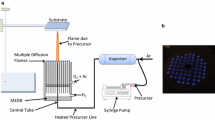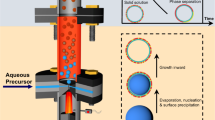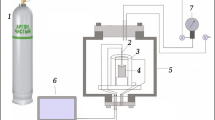Abstract
A gas-phase flame process for synthesizing unagglomerated nanoparticles of metals, intermetallics, ceramics, and composites is described. Employing this process, titanium and titanium boride have been synthesized by the vapor-phase reaction of sodium with titanium tetrachloride and a 1:2 mixture of titanium tetrachloride and boron trichloride, respectively. To minimize agglomeration and protect the particles from postflame oxidation, the NaCl by-product is allowed to condense onto the particles in situ, yielding NaCl-encapsulated particles. In this way, stable, unagglomerated Ti and TiB2 nanoparticles have been produced and the encapsulated powders have been handled in air without oxidation. Particle size has also been varied with the encapsulation process, and titanium particles with mean sizes of 10 and 60 nm have been produced by varying operating conditions. The NaCl has been removed by water washing as well as vacuum annealing. Thermodynamic results show that the sodium/halide process is applicable for synthesis of many materials, with yields approaching 100 pct under a wide range of operating conditions. Similarly, the encapsulation process is generally applicable, making the sodium/halide flame and encapsulation process a viable one for large-scale synthesis of environmentally insensitive nanopowders.
Similar content being viewed by others
References
A. Gurav, T. Kodas, T. Pluym, and Y. Xiong: Aerosol Sci. Technol., 1993, vol. 19, pp. 411–52.
G.D. Ulrich: Chem. Eng. News, 1984, vol. 62 (32) pp. 22–29.
G.W. Kriechbaum and P. Kleinschmit: Angew. Chem. Adv. Mater., 1989, vol. 101, p. 1446.
C.M. Megaridis and R.A. Dobbins: Combust. Sci. Technol., 1990, vol. 71, pp. 95–109.
S.M.L. Sastry, T.C. Peng, and R.J. Lederich: in Mechanical Behavior of Rapidly Solidified Materials, S.M.L. Sastry and B.A. MacDonald, eds., AIME, Warrendale, PA, 1986, p. 207.
H.F. Calcote and W. Felder: 24th Int. Symp. on Combustion, The Combustion Institute, Pittsburgh, PA, 1992, pp. 1869–76.
I. Glassman, K.A. Davis, and K. Brezinsky: 24th Int. Symp. on Combustion, The Combustion Institute, Pittsburgh, PA, 1992, pp. 1877–82.
R.L. Axelbaum, S.E. Bates, W.E. Buhro, C.A. Frey, K.F. Kelton, S.A. Lawton, L.J. Rosen, and S.M.L. Sastry: Nanostr. Mater., 1993, vol. 2 (2) pp. 139–47.
R.L. Axelbaum, D.P. DuFaux, and L.J. Rosen: “Method and Apparatus for Producing High Purity and Unagglomerated Submicron Particles,” U.S. Patent No. 5,489,446, Mar. 12, 1996.
R.L. Axelbaum, D.P. DuFaux, C.A. Frey, K.F. Kelton, S.A. Lawton, and S.M.L. Sastry: J. Mater. Res., 1996, vol. 11 (4), pp. 948–54.
D.P. DuFaux and R.L. Axelbaum: Combust. Flame, 1995, vol. 100, pp. 350–58.
R.W. Siegel: Ann. Rev. Mater. Sci., 1991, vol. 21 pp. 559–78.
Y. Xiong, S.E. Pratsinis, and S.V.R. Mastrangelo: J. Colloid Interface Sci., 1992, vol. 153 (1), pp. 106–17.
M.R. Zachariah and P. Dimitriou: Aerosol Sci. Technol., 1990, vol. 13, pp. 413–25.
Alkali Halide Vapors, Structure, Spectra, and Reaction Dynamics, P. Davidovits and D.L. McFadden, eds., Academic Press, New York, NY, 1979.
W.C. Reynolds: STANJAN-Interactive Computer Programs for Chemical Equilibrium Analysis, Stanford University, Stanford, CA, 1987.
J.H. Seinfeld: Atmospheric Chemistry and Physics of Air Pollution, John Wiley, New York, NY, 1986, pp. 343–84.
R.L. Axelbaum, C.R. Lottes, J.I. Huertas, and L.J. Rosen: 26th Int. Symp. on Combustion, The Combustion Institute, Pittsburgh, PA, 1996, pp. 1891–97.
R.A. Dobbins and C.M. Megaridis: Langmuir, 1987, vol. 3 (2) pp. 254–59.
D.E. Rosner, D.W. Mackowski, and P. Garcia-Ybarra: Combust. Sci. Technol., 1991, vol. 80, pp. 87–101.
J. Du and R.L. Axelbaum: Combust. Flame, 1995, vol. 100, pp. 367–75.
C.A. Frey, S.M.L. Sastry, D.P. DuFaux, K.F. Kelton, and R.L. Axelbaum: unpublished research.
Author information
Authors and Affiliations
Rights and permissions
About this article
Cite this article
Axelbaum, R.L., Sastry, S.M.L., Dufaux, D.P. et al. A flame process for synthesis of unagglomerated, low-oxygen nanoparticles: Application to Ti and TiB2 . Metall Mater Trans B 28, 1199–1211 (1997). https://doi.org/10.1007/s11663-997-0076-5
Received:
Issue Date:
DOI: https://doi.org/10.1007/s11663-997-0076-5




